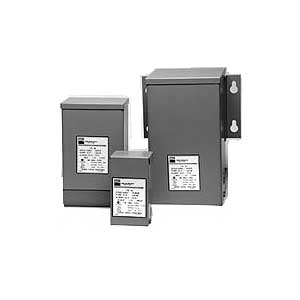
Buck-Boost transformers are small, single phase, dry type distribution transformers designed and shipped as insulating/isolating transformers. They have a dual voltage primary and a dual voltage secondary. These transformers can be connected for a wide range of voltage combinations. The most common use is to buck (lower) or boost (raise) the supply voltage a small amount, usually 5 to 27%. Buck-Boost transformers are in compliance with NEC Article 210-9, Exception 1 when field connected as an autotransformer.
The major advantages of Buck-boost transformers are their low cost, compact size and light weight. They are also more efficient and cost less than equivalent isolation transformers. When connected as an autotransformer, they can handle loads up to 20 times the nameplate rating. A buck-boost transformer is the ideal solution for changing line voltage by small amounts.
When a buck-boost has the primary and secondary windings connected, per recommended instructions, it becomes an autotransformer. Now only the secondary windings are transforming voltage and current. The majority of the KVA load passes directly from the supply to the load. This is why buck-boost transformers can supply a load with a much larger KVA rating than the nameplate indicates.
| Mfr. Part No. | Description |
| HS19B50 | Maximum Secondary Voltage Amperage, 12V, 4.16 |
| HS19B100 | Maximum Secondary Voltage Amperage, 12V, 8.33 |
| HS19B150 | Maximum Secondary Voltage Amperage, 12V, 12.5 |
| HS19B250 | Maximum Secondary Voltage Amperage, 12V, 20.8 |
| HS19F500B | Maximum Secondary Voltage Amperage, 12V, 41.6 |
| HS19F750B | Maximum Secondary Voltage Amperage, 12V, 62.5 |
| HS19F1B | Maximum Secondary Voltage Amperage, 12V, 83.3 |
| HS19F1.5A | Maximum Secondary Voltage Amperage, 12V, 125 |
| HS19F2A | Maximum Secondary Voltage Amperage, 12V, 166.6 |
| HS19F3A | Maximum Secondary Voltage Amperage, 12V, 250 |
| HS19F5A | Maximum Secondary Voltage Amperage, 12V, 416.5 |
| HS19F7.5A | Maximum Secondary Voltage Amperage, 12V, 625 |
| HS20B150 | Maximum Secondary Voltage Amperage, 12V, 9.38 |
| HS20B250 | Maximum Secondary Voltage Amperage, 12V, 15.6 |
| HS20F500B | Maximum Secondary Voltage Amperage, 12V, 31.2 |
| HS20F750B | Maximum Secondary Voltage Amperage, 12V, 46.8 |
| HS20F1B | Maximum Secondary Voltage Amperage, 12V, 62.5 |
| HS20F1.5A | Maximum Secondary Voltage Amperage, 12V, 93.7 |
| HS20F2A | Maximum Secondary Voltage Amperage, 12V, 125 |
| HS20F3A | Maximum Secondary Voltage Amperage, 12V, 187.5 |